Update February 4, 2020
A recent comparison of INMCM5 with other CMIP6 climate models is discussed at the post:
Climate Models: Good, Bad and Ugly
A previous analysis Temperatures According to Climate Models showed that only one of 42 CMIP5 models was close to hindcasting past temperature fluctuations. That model was INMCM4, which also projected an unalarming 1.4C warming to the end of the century, in contrast to the other models programmed for future warming five times the past.
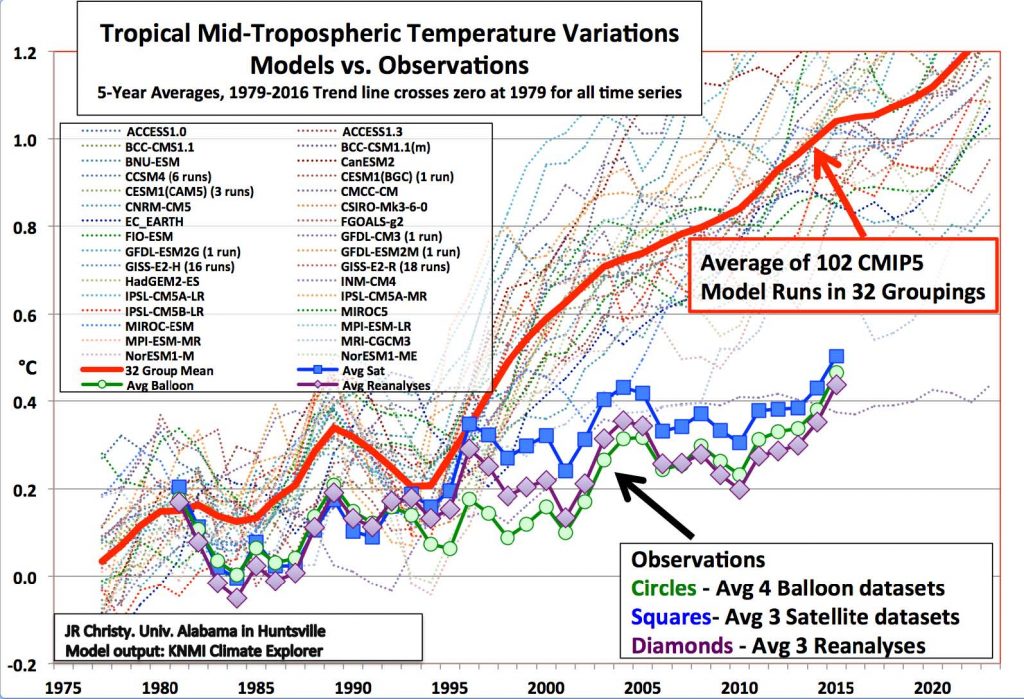
In a recent comment thread, someone asked what has been done recently with that model, given that it appears to be “best of breed.” So I went looking and this post summarizes further work to produce a new, hopefully improved version by the modelers at the Institute of Numerical Mathematics of the Russian Academy of Sciences.
A previous post a year ago went into the details of improvements made in producing the latest iteration INMCM5 for entry into the CMIP6 project. That text is reprinted below. Now we have some initial and promising results Simulation of observed climate changes in 1850-2014 with climate model INM-CM5 published May 8, 2018 by Evgeny Volodin and Andrey Gritsun in Earth Systems Dynamics. Excerpts in italics with my bolds.
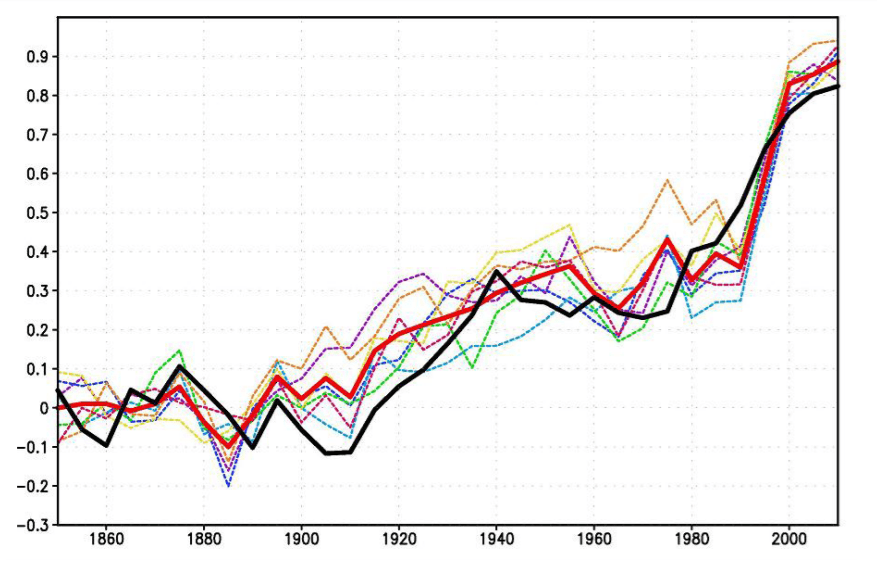
Figure 1. The 5-year mean GMST (K) anomaly with respect to 1850–1899 for HadCRUTv4 (thick solid black); model mean (thick solid red). Dashed thin lines represent data from individual model runs: 1 – purple, 2 – dark blue, 3 – blue, 4 – green, 5 – yellow, 6 – orange, 7 – magenta. In this and the next figures numbers on the time axis indicate the first year of the 5-year mean.
Abstract
Climate changes observed in 1850-2014 are modeled and studied on the basis of seven historical runs with the climate model INM-CM5 under the scenario proposed for Coupled Model Intercomparison Project, Phase 6 (CMIP6). In all runs global mean surface temperature rises by 0.8 K at the end of the experiment (2014) in agreement with the observations. Periods of fast warming in 1920-1940 and 1980-2000 as well as its slowdown in 1950-1975 and 2000-2014 are correctly reproduced by the ensemble mean. The notable change here with respect to the CMIP5 results is correct reproduction of the slowdown of global warming in 2000-2014 that we attribute to more accurate description of the Solar constant in CMIP6 protocol. The model is able to reproduce correct behavior of global mean temperature in 1980-2014 despite incorrect phases of the Atlantic Multidecadal Oscillation and Pacific Decadal Oscillation indices in the majority of experiments. The Arctic sea ice loss in recent decades is reasonably close to the observations just in one model run; the model underestimates Arctic sea ice loss by the factor 2.5. Spatial pattern of model mean surface temperature trend during the last 30 years looks close the one for the ERA Interim reanalysis. Model correctly estimates the magnitude of stratospheric cooling.
Additional Commentary
Observational data of GMST for 1850-2014 used for verification of model results were produced by HadCRUT4 (Morice et al 2012). Monthly mean sea surface temperature (SST) data ERSSTv4 (Huang et al 2015) are used for comparison of the AMO and PDO indices with that of the model. Data of Arctic sea ice extent for 1979-2014 derived from satellite observations are taken from Comiso and Nishio (2008). Stratospheric temperature trend and geographical distribution of near surface air temperature trend for 1979-2014 are calculated from ERA Interim reanalysis data (Dee et al 2011).
Keeping in mind the arguments that the GMST slowdown in the beginning of 21st 6 century could be due to the internal variability of the climate system let us look at the behavior of the AMO and PDO climate indices. Here we calculated the AMO index in the usual way, as the SST anomaly in Atlantic at latitudinal band 0N-60N minus anomaly of the GMST. Model and observed 5 year mean AMO index time series are presented in Fig.3. The well known oscillation with a period of 60-70 years can be clearly seen in the observations. Among the model runs, only one (dashed purple line) shows oscillation with a period of about 70 years, but without significant maximum near year 2000. In other model runs there is no distinct oscillation with a period of 60-70 years but period of 20-40 years prevails. As a result none of seven model trajectories reproduces behavior of observed AMO index after year 1950 (including its warm phase at the turn of the 20th and 21st centuries). One can conclude that anthropogenic forcing is unable to produce any significant impact on the AMO dynamics as its index averaged over 7 realization stays around zero within one sigma interval (0.08). Consequently, the AMO dynamics is controlled by internal variability of the climate system and cannot be predicted in historic experiments. On the other hand the model can correctly predict GMST changes in 1980-2014 having wrong phase of the AMO (blue, yellow, orange lines on Fig.1 and 3).
Conclusions
Seven historical runs for 1850-2014 with the climate model INM-CM5 were analyzed. It is shown that magnitude of the GMST rise in model runs agrees with the estimate based on the observations. All model runs reproduce stabilization of GMST in 1950-1970, fast warming in 1980-2000 and a second GMST stabilization in 2000-2014 suggesting that the major factor for predicting GMST evolution is the external forcing rather than system internal variability. Numerical experiments with the previous model version (INMCM4) for CMIP5 showed unrealistic gradual warming in 1950-2014. The difference between the two model results could be explained by more accurate modeling of stratospheric volcanic and tropospheric anthropogenic aerosol radiation effect (stabilization in 1950-1970) due to the new aerosol block in INM-CM5 and more accurate prescription of Solar constant scenario (stabilization in 2000-2014) in CMIP6 protocol. Four of seven INM-CM5 model runs simulate acceleration of warming in 1920-1940 in a correct way, other three produce it earlier or later than in reality. This indicates that for the year warming of 1920-1940 the climate system natural variability plays significant role. No model trajectory reproduces correct time behavior of AMO and PDO indices. Taking into account our results on the GMST modeling one can conclude that anthropogenic forcing does not produce any significant impact on the dynamics of AMO and PDO indices, at least for the INM-CM5 model. In turns, correct prediction of the GMST changes in the 1980-2014 does not require correct phases of the AMO and PDO as all model runs have correct values of the GMST while in at least three model experiments the phases of the AMO and PDO are opposite to the observed ones in that time. The North Atlantic SST time series produced by the model correlates better with the observations in 1980-2014. Three out of seven trajectories have strongly positive North Atlantic SST anomaly as the observations (in the other four cases we see near-to-zero changes for this quantity). The INMCM5 has the same skill for prediction of the Arctic sea ice extent in 2000-2014 as CMIP5 models including INMCM4. It underestimates the rate of sea ice loss by a factor between the two and three. In one extreme case the magnitude of this decrease is as large as in the observations while in the other the sea ice extent does not change compared to the preindustrial ages. In part this could be explained by the strong internal variability of the Arctic sea ice but obviously the new version of INMCM model and new CMIP6 forcing protocol does not improve prediction of the Arctic sea ice extent response to anthropogenic forcing.
Previous Post: Climate Model Upgraded: INMCM5 Under the Hood
Earlier in 2017 came this publication Simulation of the present-day climate with the climate model INMCM5 by E.M. Volodin et al. Excerpts below with my bolds.
In this paper we present the fifth generation of the INMCM climate model that is being developed at the Institute of Numerical Mathematics of the Russian Academy of Sciences (INMCM5). The most important changes with respect to the previous version (INMCM4) were made in the atmospheric component of the model. Its vertical resolution was increased to resolve the upper stratosphere and the lower mesosphere. A more sophisticated parameterization of condensation and cloudiness formation was introduced as well. An aerosol module was incorporated into the model. The upgraded oceanic component has a modified dynamical core optimized for better implementation on parallel computers and has two times higher resolution in both horizontal directions.
Analysis of the present-day climatology of the INMCM5 (based on the data of historical run for 1979–2005) shows moderate improvements in reproduction of basic circulation characteristics with respect to the previous version. Biases in the near-surface temperature and precipitation are slightly reduced compared with INMCM4 as well as biases in oceanic temperature, salinity and sea surface height. The most notable improvement over INMCM4 is the capability of the new model to reproduce the equatorial stratospheric quasi-biannual oscillation and statistics of sudden stratospheric warmings.
The family of INMCM climate models, as most climate system models, consists of two main blocks: the atmosphere general circulation model, and the ocean general circulation model. The atmospheric part is based on the standard set of hydrothermodynamic equations with hydrostatic approximation written in advective form. The model prognostic variables are wind horizontal components, temperature, specific humidity and surface pressure.
Atmosphere Module
The INMCM5 borrows most of the atmospheric parameterizations from its previous version. One of the few notable changes is the new parameterization of clouds and large-scale condensation. In the INMCM5 cloud area and cloud water are computed prognostically according to Tiedtke (1993). That includes the formation of large-scale cloudiness as well as the formation of clouds in the atmospheric boundary layer and clouds of deep convection. Decrease of cloudiness due to mixing with unsaturated environment and precipitation formation are also taken into account. Evaporation of precipitation is implemented according to Kessler (1969).
In the INMCM5 the atmospheric model is complemented by the interactive aerosol block, which is absent in the INMCM4. Concentrations of coarse and fine sea salt, coarse and fine mineral dust, SO2, sulfate aerosol, hydrophilic and hydrophobic black and organic carbon are all calculated prognostically.

Ocean Module
The oceanic module of the INMCM5 uses generalized spherical coordinates. The model “South Pole” coincides with the geographical one, while the model “North Pole” is located in Siberia beyond the ocean area to avoid numerical problems near the pole. Vertical sigma-coordinate is used. The finite-difference equations are written using the Arakawa C-grid. The differential and finite-difference equations, as well as methods of solving them can be found in Zalesny etal. (2010).
The INMCM5 uses explicit schemes for advection, while the INMCM4 used schemes based on splitting upon coordinates. Also, the iterative method for solving linear shallow water equation systems is used in the INMCM5 rather than direct method used in the INMCM4. The two previous changes were made to improve model parallel scalability. The horizontal resolution of the ocean part of the INMCM5 is 0.5 × 0.25° in longitude and latitude (compared to the INMCM4’s 1 × 0.5°).
Both the INMCM4 and the INMCM5 have 40 levels in vertical. The parallel implementation of the ocean model can be found in (Terekhov etal. 2011). The oceanic block includes vertical mixing and isopycnal diffusion parameterizations (Zalesny et al. 2010). Sea ice dynamics and thermodynamics are parameterized according to Iakovlev (2009). Assumptions of elastic-viscous-plastic rheology and single ice thickness gradation are used. The time step in the oceanic block of the INMCM5 is 15 min.
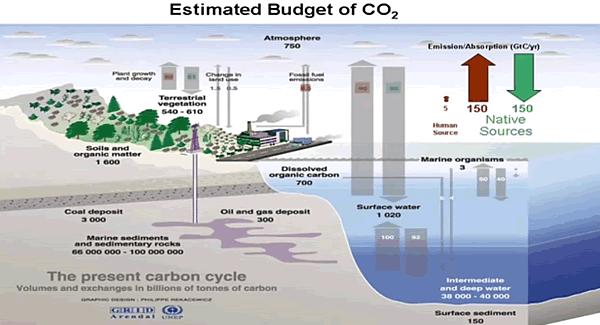
Note the size of the human emissions next to the red arrow.
Carbon Cycle Module
The climate model INMCM5 has а carbon cycle module (Volodin 2007), where atmospheric CO2 concentration, carbon in vegetation, soil and ocean are calculated. In soil, а single carbon pool is considered. In the ocean, the only prognostic variable in the carbon cycle is total inorganic carbon. Biological pump is prescribed. The model calculates methane emission from wetlands and has a simplified methane cycle (Volodin 2008). Parameterizations of some electrical phenomena, including calculation of ionospheric potential and flash intensity (Mareev and Volodin 2014), are also included in the model.
Surface Temperatures
When compared to the INMCM4 surface temperature climatology, the INMCM5 shows several improvements. Negative bias over continents is reduced mainly because of the increase in daily minimum temperature over land, which is achieved by tuning the surface flux parameterization. In addition, positive bias over southern Europe and eastern USA in summer typical for many climate models (Mueller and Seneviratne 2014) is almost absent in the INMCM5. A possible reason for this bias in many models is the shortage of soil water and suppressed evaporation leading to overestimation of the surface temperature. In the INMCM5 this problem was addressed by the increase of the minimum leaf resistance for some vegetation types.
Nevertheless, some problems migrate from one model version to the other: negative bias over most of the subtropical and tropical oceans, and positive bias over the Atlantic to the east of the USA and Canada. Root mean square (RMS) error of annual mean near surface temperature was reduced from 2.48 K in the INMCM4 to 1.85 K in the INMCM5.
Precipitation
In mid-latitudes, the positive precipitation bias over the ocean prevails in winter while negative bias occurs in summer. Compared to the INMCM4, the biases over the western Indian Ocean, Indonesia, the eastern tropical Pacific and the tropical Atlantic are reduced. A possible reason for this is the better reproduction of the tropical sea surface temperature (SST) in the INMCM5 due to the increase of the spatial resolution in the oceanic block, as well as the new condensation scheme. RMS annual mean model bias for precipitation is 1.35mm day−1 for the INMCM5 compared to 1.60mm day−1 for the INMCM4.
Cloud Radiation Forcing
Cloud radiation forcing (CRF) at the top of the atmosphere is one of the most important climate model characteristics, as errors in CRF frequently lead to an incorrect surface temperature.
In the high latitudes model errors in shortwave CRF are small. The model underestimates longwave CRF in the subtropics but overestimates it in the high latitudes. Errors in longwave CRF in the tropics tend to partially compensate errors in shortwave CRF. Both errors have positive sign near 60S leading to warm bias in the surface temperature here. As a result, we have some underestimation of the net CRF absolute value at almost all latitudes except the tropics. Additional experiments with tuned conversion of cloud water (ice) to precipitation (for upper cloudiness) showed that model bias in the net CRF could be reduced, but that the RMS bias for the surface temperature will increase in this case.
A table from another paper provides the climate parameters described by INMCM5.
| Climate Parameters | Observations | INMCM3 | INMCM4 | INMCM5 |
| Incoming solar radiation at TOA | 341.3 [26] | 341.7 | 341.8 | 341.4 |
| Outgoing solar radiation at TOA | 96–100 [26] | 97.5 ± 0.1 | 96.2 ± 0.1 | 98.5 ± 0.2 |
| Outgoing longwave radiation at TOA | 236–242 [26] | 240.8 ± 0.1 | 244.6 ± 0.1 | 241.6 ± 0.2 |
| Solar radiation absorbed by surface | 154–166 [26] | 166.7 ± 0.2 | 166.7 ± 0.2 | 169.0 ± 0.3 |
| Solar radiation reflected by surface | 22–26 [26] | 29.4 ± 0.1 | 30.6 ± 0.1 | 30.8 ± 0.1 |
| Longwave radiation balance at surface | –54 to 58 [26] | –52.1 ± 0.1 | –49.5 ± 0.1 | –63.0 ± 0.2 |
| Solar radiation reflected by atmosphere | 74–78 [26] | 68.1 ± 0.1 | 66.7 ± 0.1 | 67.8 ± 0.1 |
| Solar radiation absorbed by atmosphere | 74–91 [26] | 77.4 ± 0.1 | 78.9 ± 0.1 | 81.9 ± 0.1 |
| Direct hear flux from surface | 15–25 [26] | 27.6 ± 0.2 | 28.2 ± 0.2 | 18.8 ± 0.1 |
| Latent heat flux from surface | 70–85 [26] | 86.3 ± 0.3 | 90.5 ± 0.3 | 86.1 ± 0.3 |
| Cloud amount, % | 64–75 [27] | 64.2 ± 0.1 | 63.3 ± 0.1 | 69 ± 0.2 |
| Solar radiation-cloud forcing at TOA | –47 [26] | –42.3 ± 0.1 | –40.3 ± 0.1 | –40.4 ± 0.1 |
| Longwave radiation-cloud forcing at TOA | 26 [26] | 22.3 ± 0.1 | 21.2 ± 0.1 | 24.6 ± 0.1 |
| Near-surface air temperature, °С | 14.0 ± 0.2 [26] | 13.0 ± 0.1 | 13.7 ± 0.1 | 13.8 ± 0.1 |
| Precipitation, mm/day | 2.5–2.8 [23] | 2.97 ± 0.01 | 3.13 ± 0.01 | 2.97 ± 0.01 |
| River water inflow to the World Ocean,10^3 km^3/year | 29–40 [28] | 21.6 ± 0.1 | 31.8 ± 0.1 | 40.0 ± 0.3 |
| Snow coverage in Feb., mil. Km^2 | 46 ± 2 [29] | 37.6 ± 1.8 | 39.9 ± 1.5 | 39.4 ± 1.5 |
| Permafrost area, mil. Km^2 | 10.7–22.8 [30] | 8.2 ± 0.6 | 16.1 ± 0.4 | 5.0 ± 0.5 |
| Land area prone to seasonal freezing in NH, mil. Km^2 | 54.4 ± 0.7 [31] | 46.1 ± 1.1 | 48.3 ± 1.1 | 51.6 ± 1.0 |
| Sea ice area in NH in March, mil. Km^2 | 13.9 ± 0.4 [32] | 12.9 ± 0.3 | 14.4 ± 0.3 | 14.5 ± 0.3 |
| Sea ice area in NH in Sept., mil. Km^2 | 5.3 ± 0.6 [32] | 4.5 ± 0.5 | 4.5 ± 0.5 | 6.1 ± 0.5 |
Heat flux units are given in W/m^2; the other units are given with the title of corresponding parameter. Where possible, ± shows standard deviation for annual mean value. Source: Simulation of Modern Climate with the New Version Of the INM RAS Climate Model (Bracketed numbers refer to sources for observations)
Ocean Temperature and Salinity
The model biases in potential temperature and salinity averaged over longitude with respect to WOA09 (Antonov et al. 2010) are shown in Fig.12. Positive bias in the Southern Ocean penetrates from the surface downward for up to 300 m, while negative bias in the tropics can be seen even in the 100–1000 m layer.
Nevertheless, zonal mean temperature error at any level from the surface to the bottom is small. This was not the case for the INMCM4, where one could see negative temperature bias up to 2–3 K from 1.5 km to the bottom nearly al all latitudes, and 2–3 K positive bias at levels of 700–1000 m. The reason for this improvement is the introduction of a higher background coefficient for vertical diffusion at high depth (3000 m and higher) than at intermediate depth (300–500m). Positive temperature bias at 45–65 N at all depths could probably be explained by shortcomings in the representation of deep convection [similar errors can be seen for most of the CMIP5 models (Flato etal. 2013, their Fig.9.13)].
Another feature common for many present day climate models (and for the INMCM5 as well) is negative bias in southern tropical ocean salinity from the surface to 500 m. It can be explained by overestimation of precipitation at the southern branch of the Inter Tropical Convergence zone. Meridional heat flux in the ocean (Fig.13) is not far from available estimates (Trenberth and Caron 2001). It looks similar to the one for the INMCM4, but maximum of northward transport in the Atlantic in the INMCM5 is about 0.1–0.2 × 1015 W higher than the one in the INMCM4, probably, because of the increased horizontal resolution in the oceanic block.
Sea Ice
In the Arctic, the model sea ice area is just slightly overestimated. Overestimation of the Arctic sea ice area is connected with negative bias in the surface temperature. In the same time, connection of the sea ice area error with the positive salinity bias is not evident because ice formation is almost compensated by ice melting, and the total salinity source for these pair of processes is not large. The amplitude and phase of the sea ice annual cycle are reproduced correctly by the model. In the Antarctic, sea ice area is underestimated by a factor of 1.5 in all seasons, apparently due to the positive temperature bias. Note that the correct simulation of sea ice area dynamics in both hemispheres simultaneously is a difficult task for climate modeling.
The analysis of the model time series of the SST anomalies shows that the El Niño event frequency is approximately the same in the model and data, but the model El Niños happen too regularly. Atmospheric response to the El Niño vents is also underestimated in the model by a factor of 1.5 with respect to the reanalysis data.
Conclusion
Based on the CMIP5 model INMCM4 the next version of the Institute of Numerical Mathematics RAS climate model was developed (INMCM5). The most important changes include new parameterizations of large scale condensation (cloud fraction and cloud water are now the prognostic variables), and increased vertical resolution in the atmosphere (73 vertical levels instead of 21, top model level raised from 30 to 60 km). In the oceanic block, horizontal resolution was increased by a factor of 2 in both directions.
The climate model was supplemented by the aerosol block. The model got a new parallel code with improved computational efficiency and scalability. With the new version of climate model we performed a test model run (80 years) to simulate the present-day Earth climate. The model mean state was compared with the available datasets. The structures of the surface temperature and precipitation biases in the INMCM5 are typical for the present climate models. Nevertheless, the RMS error in surface temperature, precipitation as well as zonal mean temperature and zonal wind are reduced in the INMCM5 with respect to its previous version, the INMCM4.
The model is capable of reproducing equatorial stratospheric QBO and SSWs.The model biases for the sea surface height and surface salinity are reduced in the new version as well, probably due to increasing spatial resolution in the oceanic block. Bias in ocean potential temperature at depths below 700 m in the INMCM5 is also reduced with respect to the one in the INMCM4. This is likely because of the tuning background vertical diffusion coefficient.
Model sea ice area is reproduced well enough in the Arctic, but is underestimated in the Antarctic (as a result of the overestimated surface temperature). RMS error in the surface salinity is reduced almost everywhere compared to the previous model except the Arctic (where the positive bias becomes larger). As a final remark one can conclude that the INMCM5 is substantially better in almost all aspects than its previous version and we plan to use this model as a core component for the coming CMIP6 experiment.

Summary
One the one hand, this model example shows that the intent is simple: To represent dynamically the energy balance of our planetary climate system. On the other hand, the model description shows how many parameters are involved, and the complexity of processes interacting. The attempt to simulate operations of the climate system is a monumental task with many outstanding challenges, and this latest version is another step in an iterative development.
Note: Regarding the influence of rising CO2 on the energy balance. Global warming advocates estimate a CO2 perturbation of 4 W/m^2. In the climate parameters table above, observations of the radiation fluxes have a 2 W/m^2 error range at best, and in several cases are observed in ranges of 10 to 15 W/m^2.
We do not yet have access to the time series temperature outputs from INMCM5 to compare with observations or with other CMIP6 models. Presumably that will happen in the future.
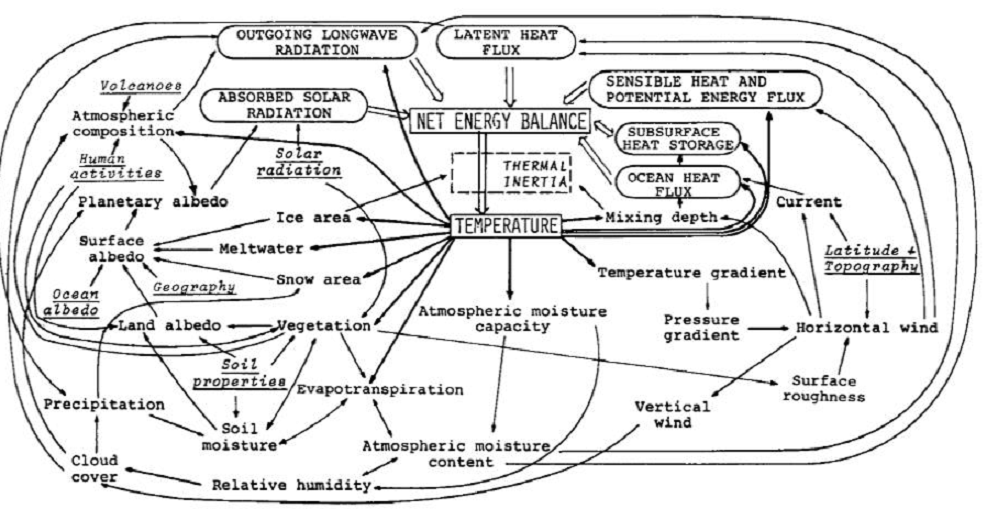
Early Schematic: Flows and Feedbacks for Climate Models

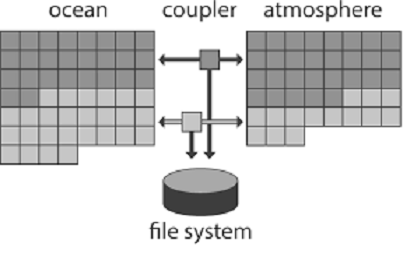
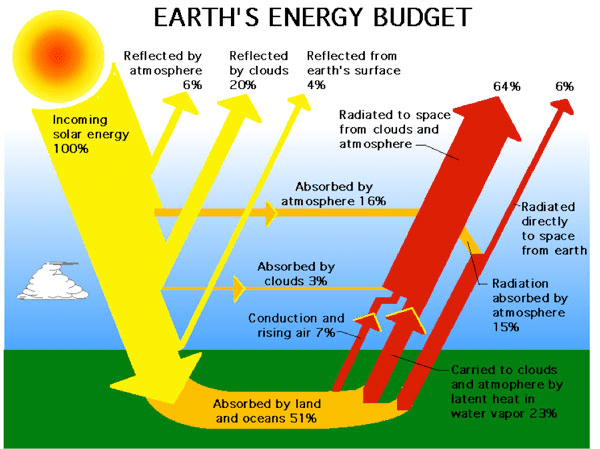
Reblogged this on Climate Collections.
LikeLike
Ron, again thanks for this highly interesting (at least to me) look inside the new INMCM5 model … I’ll repeat my question from last year … do we have new data yet to recreate the “102 climate model runs” graphic with the CIMP6 data yet?
“…it would be very helpful to the less technical reader if you could create a graphic similar to the Models vs Observation one at top of this article that shows the INMCM5 output compared to the previous INMCM4 output?
Better yet add the INMCM5 results to the 102 models vs obsrved graphic.”
LikeLike
A. Scott, thanks for the comment. You are focused on the key issue, but AFAIK the CMIP6 project is not there yet. They are still qualifying models for inclusion into the “experiment.” And I have not yet seen a forecast from INMCM5.
LikeLike
Just a reminder on CIMP6 and the INMCM5 model
LikeLike
Thanks for reminding A. Scott. Here’s what I found:

LikeLike
It’s great to see the guts of what they are doing so clearly shown. Although the changes described can surely be justified individually, it still looks like post hoc curve fitting, and doesn’t tell us much about whether the basic assumptions used about CO2 forcing hold good. Time will tell, I guess.
Many thanks for putting this up, Ron. Like your blog very much.
LikeLike
Thanks mothcatcher. I am not expert in what they are doing building climate models, but I respect the complexity of the attempt. I think no one knows what were the initial conditions in 1850. I also think the people at INM made a good faith effort to obtain reasonable estimates for their runs. I do think they are one of the few (only one?) modeling center that is not pressured to produce an alarmist projection. I also think it likely their hindcast will turn out to be the closest to history as estimated by HadCRUT4.
LikeLike
Dear Ron, Can I ask what is the difference between INM CN4/5 and other climate models that makes it give such different results? Is there a particular module that is fundamentally different or is it a combination of many factors. Apologies if you have already answered this question. Peter Ridd
LikeLike
Thanks for asking Peter. Here’s what I found looking for the answer.
What’s different about the best model?
Above, I showed how one CMIP5 model produced historical temperature trends closely comparable to HADCRUT4. That same model, INMCM4, was also closest to Berkeley Earth and RSS series.
Curious about what makes this model different from the others, I consulted several comparative surveys of CMIP5 models. There appear to be 3 features of INMCM4 that differentiate it from the others.
1.INMCM4 has the lowest CO2 forcing response at 4.1K for 4XCO2. That is 37% lower than multi-model mean.
2.INMCM4 has by far the highest climate system inertia: Deep ocean heat capacity in INMCM4 is 317 W yr m^-2 K^-1, 200% of the mean (which excluded INMCM4 because it was such an outlier).
3.INMCM4 exactly matches observed atmospheric H2O content in lower troposphere (215 hPa), and is biased low above that. Most others are biased high.
So the model that most closely reproduces the temperature history has high inertia from ocean heat capacities, low forcing from CO2 and less water for feedback. Why aren’t the other models built like this one?
From https://rclutz.wordpress.com/2015/03/24/temperatures-according-to-climate-models/
LikeLiked by 1 person
Thanks Ron, Very interesting. Have the authors of INMCM4 written anything on the differences and why they think that their treatment is more valid (apart from the fact that it seems to give better results). I’d certainly like to know more about the water vapour and CO2 forcing components. Do you have any suggestions on who I could contact directly. I am preparing a paper on the performance of models and it has surprised me that there is not more written about why this model gives such different results considering that we are supposed to put our faith in these models. PVR
LikeLike
Evgeny Volodin leads the INM modelling program. In this recent paper he draws attention to changes in the solar constant parameter for all CMIP6 models plus an improved aerosol block in INMCM5
https://www.researchgate.net/profile/Andrey_Gritsun2/publication/328181512_Nature_of_the_Decrease_in_Global_Warming_at_the_Beginning_of_the_21st_Century/links/5bd360eca6fdcc3a8da91bff/Nature-of-the-Decrease-in-Global-Warming-at-the-Beginning-of-the-21st-Century.pdf?origin=publication_detail
LikeLiked by 1 person
When they get it all fine tuned, will they be able to run it backwards, hindcast, for 20,000 years an get an ice age with a mile or 2 of ice over Canada
LikeLike
John, you are pushing it. It is hard enough to get supercomputers to get a lift over analog climate forecasting going forward a single decade. Dr. R.G. Brown of Duke University explains what is involved at this post:
https://rclutz.wordpress.com/2015/06/11/climate-models-explained/
LikeLike
A recent Canadian study forecast a doubling if warming over previous forecasts. The baseline was 1986 to 2005. It started in a solar minimum like now and ended in the second year od an El Nino: cold to warm, they cooked the books. The study coincided with the introduction of the federal carbon dioxide tax.
LikeLike
As a Canadian I am appalled at every release from Environment Canada, aka climate change boosters north. The main problem with every statement concerning temperatures is that there is no rational, long-term, temperature record to be found. Hence, the out of control climate alarmists, aka the government of Canada, can state anything they wish as a base temperature.
Whatever actual temperature records that did exist have been altered to fit the purpose, and are not recoverable IMO.
LikeLike
This is what really happened and must be ignored at all cost.
https://www.dropbox.com/s/4473qqg9dw8lugm/Volcanoes%20ENSO%20and%20Carbon%20Dioxide.pdf?dl=0
LikeLike
If I remember correctly, during the “International Geophysical Year” in the 1950’s, the Russians put more research sites into operation than anyone else, and then they kept them operating afterwards. Could be that they have a much better idea of changing arctic conditions than anyone else and factored that knowledge into their model.
LikeLike
Thanks for that comment Graham. They are well connected to AARI in St. Petersberg, a leading research center on the Arctic, not to mention reports from their fleet of icebreakers each year. I do think that most important is the freedom to operate in a political environment where your research funding is not tied to climate alarms.
LikeLike
Government Science is an oxymoron.
“Yet, in holding scientific research and discovery in respect, as we should, we must also be alert to the equal and opposite danger that public policy could itself become the captive of a scientific-technological elite.” Dwight Eisenhower – final address as President 1961
LikeLike
I think the prime assumption is false…
https://www.dropbox.com/s/cpga49bbnn7q062/It%27s%20not%20the%20heat….pdf?dl=0
and
https://www.dropbox.com/s/a84vty7dl5ojmm8/Those%20Hunger%20Stones.pdf?dl=0
but most important…
https://www.dropbox.com/s/kedbsty8xqke5gw/Volcanoes%20ENSO%20and%20Carbon%20Dioxide.pdf?dl=0
HAPPY NEW YEAR!
LikeLike